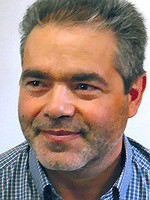abstract
The addition of resorbable beta-tricalcium phosphate (beta-TCP) to other bone substitute materials such as hydroxyapatite (HA) has been pointed out as a suitable strategy to enhance the regenerative potential of bone grafts made thereof. To check the generalization of this hypothesis, a new synthetic composite bone graft material consisting of a mixture of 30 vol% of pure beta-TCP and 70 vol% of FastOe (R) BG (an alkali-free bioactive glass - BG) was prepared and tested in vivo. The in vivo performance of the new synthetic bone graft (30 beta-TCP-70FastOs (R) BG) was compared with those of FastOs (R) BG alone and of adbone (R) BCP, a biphasic calcium phosphate, consisting of 75% of HA and 25% of beta-TCP. Two defects with 4 mm diameter were performed in Wistar rats calvaria and filled with the bone graft materials. The animals were sacrificed after 9 weeks of implantation and the calvaria was excised. Empty bone defects were used as negative control. The percentages of new bone formed (von Kassa staining) were always higher in the treated groups (FastOs (R) BG, 30 beta-TCP-70FastOs (R) BG and adbone (R) BCP) than in empty group. There were differences with statistical significance between empty and FastOs (R) BG groups and between empty and adbone (R) BCP groups. But the differences observed between empty and 30 beta-TCP-70FastOs (R) BG groups were less remarkable. The results demonstrated the superior bone regeneration ability of FastOs (R) BG alone, which was not further enhanced by adding beta-TCP in the composition, confirming its already proven regenerative potential.
keywords
CALCIUM-PHOSPHATE CERAMICS; BONE-GRAFT SUBSTITUTES; PHOSPHOSILICATE GLASSES; TRICALCIUM PHOSPHATE; FUTURE PERSPECTIVES; STEM-CELLS; SCAFFOLDS; BIOMATERIALS; STRONTIUM; BEHAVIOR
subject category
Materials Science
authors
Ferreira, MM; Brito, AF; Marques, CF; Freitas, LF; Carrilho, E; Abrantes, AM; Pires, AS; Aguiar, MJ; Carvalho, L; Botelho, MF; Ferreira, JMF
our authors
acknowledgements
Thanks are due to CICECO-Aveiro Institute of Materials (UID/CTM/50011/2013) project funded by FEDER funds through the Operational Programme Competitiveness Factors (COMPETE 2020) and the Portuguese Foundation for Science and Technology (FCT). Catarina F. Marques is grateful for the SFRH/BD/78355/2011 grant from the Foundation for Science and Technology (FCT) of Portugal. The authors also would like to thank FCT (Portugal) by the financing of PEst-UID/NEU/04539/2013 and FEDER-COMPETE (FCOMP-01-0124-FEDER-028417 and POCI-01-0145-FEDER-007440)



